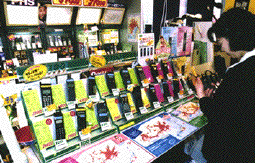 (Photo: Kyodo)
(Photo: Kyodo)BIGGER ROLE FOR PORTABLES:
Telecom Industry Making Hefty Investments
JULY 30, 1996
 (Photo: Kyodo)
(Photo: Kyodo)
A total of 1.6 trillion yen (16.7 billion dollars at the average fiscal 1995 rate of 96 yen to the dollar) will be spent by approximately 90 companies on new plant and equipment for the portable telecommunications market during the current fiscal year ending March 1997.
This is a projection made recently by the Ministry of Posts and Telecommunications; the figure represents a 62% jump over the previous year. The companies in the survey include those handling cellular phones, PHS (personal handy-phone system) phones, and pagers.
The market for these wireless communication devices is expanding rapidly. Over the past year the number of new subscribers more than doubled to upwards of 10 million. Total industry sales in fiscal 1995 jumped by an estimated 70% over the previous year to almost 2.4 trillion yen (25 billion dollars). Sales of 3.5 trillion yen (36.5 billion dollars), a further increase of 50%, are expected for the current fiscal year.
Companies in the industry are now hoping to capitalize on this surge with moves that include expanding capacity to handle more calls.
Investment in portable communications for the current fiscal year will fall short of the 3 trillion yen (31.3 billion dollars) tagged for the leasing, electric power, and electric machinery industries. But it will exceed that of the auto industry (1.25 trillion yen, or 13 billion dollars), which is moving to offshore production, and steel (730 billion yen, or 7.6 billion dollars), which has largely reached maturity.
8.5-Trillion-Yen Industry by 2000
The portable communications market is expected to continue expanding over the next several years. A recent report by a Posts and Telecommunications Ministry study group indicates that by the year 2000 the market will have more than tripled its size from 1995 to 8.5 trillion yen (88.5 billion dollars).
Hardware will account for 2.7 trillion yen (28.1 billion dollars) of this figure, with services making up the remaining 5.8 trillion yen (60.4 billion dollars). The industry will support a labor force of 236,000--around four times the present number.
The report also predicts that if a nationwide high-speed wireless communications network capable of relaying both images and voice can be established in addition to an optical fiber network, new media devices, such as portable TV telephones, will become possible and further boost the portable communications market. The report estimates that these developments will create a 17-trillion-yen (177.1-billion-dollar) market employing 562,000 by the year 2010.
A look at the 1993 figures of other major industries reveals that the electric equipment industry is worth 52.2 trillion yen (543.8 billion dollars) and employs 1,865,000 people. The market for transport machinery, including automobiles, auto parts, and ship-building, is valued at 47-trillion-yen (489.6-billion-dollar) and employs 972,000. The steel industry has a 15-trillion-yen (156.3-billion-dollar) market and 326,000 employees (figures from the Ministry of International Trade and Industry, 1993).
Wireless communications looks set, therefore, to become one of Japan's leading industries in the years to come.